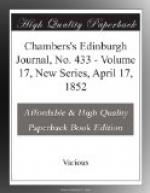Mr C—— found Ballyvourney in the inaccessible state I have described. The people held every year, on Whitsunday, a royal faction-fight; and for this, preparation was made almost every Sunday in the year. They fought with deadly weapons, sticks loaded with lead, and stones. Pensioners, who were accustomed to firearms, were hired for the occasion; but the weapon chiefly used was a short scythe, and men may still be found bearing its mark in contracted legs and arms: one man having Tim Halisy, his mark; another, Paddy Murphy, his mark, indelibly inscribed on his body. They had little or no agriculture—no wheeled cart, and scarcely even a spade. A crop of oats was a curiosity; and when there was such a thing, the only mode of conveying it to market was on a horse’s back. Their agricultural operations were confined to feeding cattle, and they depended on their milk and butter for paying their rent, and purchasing the necessaries of life. Their mode of carrying butter to Cork was curious. I have often seen crowds of thirty, forty, or fifty men, seated on little ill-formed horses, which had two panniers swinging on the back, containing frequently only a single firkin of butter in one, and a stone in the other, the man being seated between. They fed their horses on the road-side, never entering an inn-yard; and they generally travelled by night. No one would trust another with his property; and on their journey of forty Irish miles, they expended no money. The scythe was their farming-implement to cut such coarse hay as grew in the bottoms near rivers. On Whitsunday, whoever could keep possession of a large stone called Carrigun na Killeagh, was champion for the year, and the party to which he belonged was triumphant until the next annual battle. On one occasion, the battle was almost ended, the champion was possessor of the stone for nearly the prescribed time; he gave one cheer of victory, then another, and was about to give the crowning cheer, when a signal was made to a pensioner, who had been hired for the purpose, and placed in ambush. He fired, and the ball pierced the conqueror’s neck, without mortally wounding him. The man fell, and while on the ground, was seen pulling the moss and grass around him, and stuffing them into the wound, to prevent the flow of blood, that he might again mount the rock of victory. The next day he was seen out of doors by the doctor, for whom his wife had secretly sent; and after much entreaty, his determination not to allow the opposite party to know that he had been seriously hurt was overcome, and he permitted the doctor to examine the wound, and replace the styptics of his own providing with more scientific remedies.




